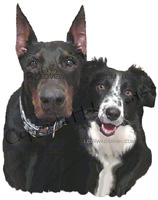Among my favorite types of clients to work with is one who has a dog who’s reactive to other dogs on leash. The kind of dog that makes a person want to crawl into a hole in the ground the minute the dog starts throwing his barky, growly display at the dog coming down the street or around the corner or out the door of a house he’s passing by.
I know the embarrassing feeling. I’ve had a couple of on-leash, dog-aggressive dogs as pets of my own. I loved them dearly, but they were the biggest challenges of my life. And I didn’t know better back then and muddled along as best I could when I was on a walk with them.
 I was always on guard, watching out for who might be coming so I could turn and go the other way, timing my walkies for those off-times when I learned most people weren’t taking a stroll with their dogs, or learning to apologize for my dog when there just was no way around the moment when we met someone and their dog face-to-face. Of course, I’d reprimand my own dog to assure the other guy I meant business. The only thing that did was give me some social sympathy because, after all, I looked as if I were doing my best. But it was mostly all wrong. Wrong, wrong, wrong. And you know what. I forgive myself because I knew no better.
I was always on guard, watching out for who might be coming so I could turn and go the other way, timing my walkies for those off-times when I learned most people weren’t taking a stroll with their dogs, or learning to apologize for my dog when there just was no way around the moment when we met someone and their dog face-to-face. Of course, I’d reprimand my own dog to assure the other guy I meant business. The only thing that did was give me some social sympathy because, after all, I looked as if I were doing my best. But it was mostly all wrong. Wrong, wrong, wrong. And you know what. I forgive myself because I knew no better.
Awww, but now I do. And now I can step up to help other people whose dogs are of that Jekyll-Hyde nature. Through the use of counterconditioning, a dog’s negative emotion can be changed to a positive one. And with that change, so changes his behavior. It takes some finesse and timing, but when a client gets the mechanics down, and keeps on the training plan, the dog’s aggressive reaction starts to mellow. Step-by-step, the process takes place, and walkies become less stressful and more enjoyable for both dog and owner.
 I’ll give you a tip. One of the things I did do right in those early times of owning an aggressive dog is the turn-and-go, and all dog owners should learn this maneuver and practice it with their dogs before they need it so they’re competent and capable of doing it when an emergency comes up. If something comes ahead of you and your dog while you’re on a walk that’s upsetting, or if your dog is reacting, pivot around and start talking happy to your dog and move away in the direction you came from. Briskly. Don’t run, but move speedily and keep the happy talk up. Happy talk is giddy, funny, baby-like talk in a high-pitched voice. When things calm down, when you’re far enough away from the upset, then give the dog a treat. This is a defensive maneuver. It’s management, and it’s very effective for times when there’s nothing else to do.
I’ll give you a tip. One of the things I did do right in those early times of owning an aggressive dog is the turn-and-go, and all dog owners should learn this maneuver and practice it with their dogs before they need it so they’re competent and capable of doing it when an emergency comes up. If something comes ahead of you and your dog while you’re on a walk that’s upsetting, or if your dog is reacting, pivot around and start talking happy to your dog and move away in the direction you came from. Briskly. Don’t run, but move speedily and keep the happy talk up. Happy talk is giddy, funny, baby-like talk in a high-pitched voice. When things calm down, when you’re far enough away from the upset, then give the dog a treat. This is a defensive maneuver. It’s management, and it’s very effective for times when there’s nothing else to do.
If you’re the owner of a Jekyll-Hyde dog, contact me. I’ll use my dog training expertise and behavior modification skills to help the both of you enjoy walkies.
By Helen Verte
Certified Pet Dog Trainer-Knowledge Assessed, Certified Trick Dog Instructor
Dog-Dog Aggression Behavior Modification, Fort Lauderdale and Broward County




